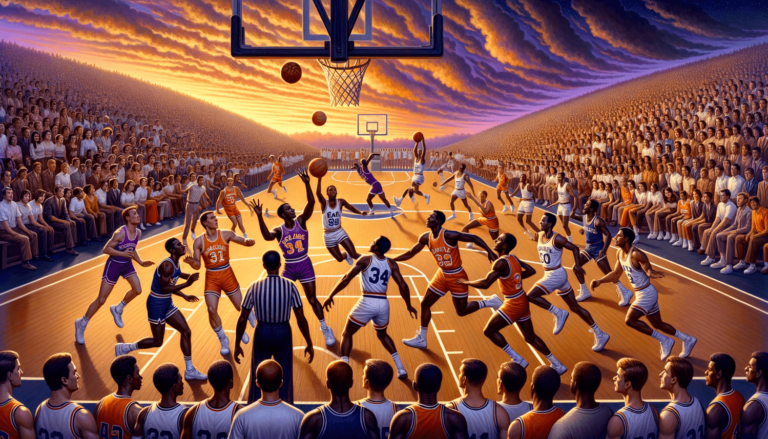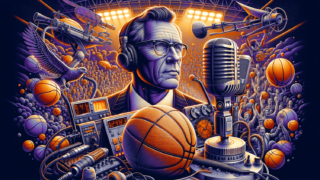
Integration of Basketball and Civil Rights Movement
Written by: Basketball Universe
Last updated:

When you think of basketball, you likely picture high-flying dunks, thrilling buzzer-beaters, and intense on-court rivalries. But have you ever considered how the sport was intricately intertwined with the Civil Rights Movement of the 1950s and 60s? In this illuminating exploration, we’ll dive deep into the vital role and significant impact of basketball in the quest for racial equality. So, lace up your sneakers and get ready to be enthralled by the captivating story of hoops and the fight for civil rights, as we embark on a journey through American history, sports, and social change.
Integration of Basketball and Civil Rights Movement
The integration of basketball and the Civil Rights Movement played a significant role in promoting racial equality in America. As racial barriers were being broken in schools and colleges, basketball provided a platform for African American athletes to showcase their talents and raise awareness of the black community’s struggle for equality. With the integration of the NBA in the 1950s and the rise of black college basketball teams during the 60s, the sport became a vital instrument of change, fostering unity and challenging societal norms. The perseverance and accomplishments of players such as Bill Russell, Wilt Chamberlain, and other African American athletes helped redefine the perception of black individuals in society, paving the way toward a more inclusive and unified future.
The Origins of Basketball and Shift in Racial Dynamics
The game of basketball was invented in 1891 by Dr. James Naismith, a physical education instructor in Springfield, Massachusetts. Initially, the sport primarily attracted white players and was controlled by white organizations. However, the early 20th century saw the rise of African American basketball teams such as the New York Renaissance (the Rens) and the Harlem Globetrotters. These trailblazing teams played a key role in transforming the racial dynamics within the sport and setting the stage for future generations of black athletes.
Breaking Barriers: Early Pioneers and NBA Integration
The integration of basketball began to take sync in the 1950s with the introduction of talented African American players, who pushed for change and broadened the sport’s appeal. Professional basketball, especially the NBA, went from being an exclusively white domain to a diverse setting. These pioneers include the first African American NBA player, Earl Lloyd, and future Hall of Famers Bill Russell and Wilt Chamberlain who, in addition to breaking records, also helped break racial barriers.
Earl Lloyd: Opening Doors in the NBA
As the first African American player to compete in an NBA game, Earl Lloyd made history on October 31, 1950, when he stepped onto the court for the Washington Capitols. Lloyd’s presence in the NBA opened doors for other talented black players and served as an inspiration for aspiring athletes of color. Although Lloyd’s professional career was modest, his impact on the sport transcended the walls of the basketball court and extended far into the realms of social change.
Bill Russell: The Quintessential Winner
Bill Russell, one of the most decorated players in basketball history, was a fierce competitor on the court and a staunch advocate for civil rights off of it. As the second black player to be drafted into the NBA, Russell made history in 1957 when he led the Boston Celtics to the first of their eleven championships during his thirteen-year career. With his extraordinary shot-blocking skills and unmatched leadership qualities, Russell helped pave the way for racial integration within the league and empowered African American athletes to fight for their rights to equal opportunity in the game.
Wilt Chamberlain: Dominance and Defiance
Wilt Chamberlain, a Kansas native and a towering presence in the world of basketball, truly disrupted the racial dynamics within the sport. His unrelenting dominance on the court had never been seen in basketball history up to that point. Chamberlain broke numerous records, including his famous 100-point game in 1962, and his impact and skill set inspired black athletes nationwide. His defiance against racism throughout his career further displayed his commitment to fight for equality not only within basketball, but also in society at large.
The Role of College Basketball and the “Game of Change”
While the integration of the NBA was crucial to breaking racial barriers in the world of professional basketball, it was college basketball’s impact that held equal significance. During the early 1960s, college teams throughout the United States resisted integrating their rosters. However, the tide shifted in 1963 during the historic “Game of Change.”
Mississippi State vs. Loyola Chicago: The Turning Point
On March 15, 1963, Mississippi State, an all-white team, faced off against the racially integrated Loyola Chicago squad in the NCAA Tournament. This iconic matchup, also known as the “Game of Change,” was a significant turning point in the integration struggle in college basketball. Despite facing numerous challenges, including a potential injunction from the Mississippi governor and death threats, the Mississippi State team traveled north to play in the game. Loyola Chicago won the historic contest, but more importantly, this game represented a meaningful shift in America’s perception of interracial sports competition.
Texas Western’s Title Run: Another Leap Forward
Fast-forward three years to 1966, another momentous year in the history of college basketball, as the Texas Western College Miners defeated the top-ranked Kentucky Wildcats in the NCAA Championship. With an all-black starting lineup against the entirely white Kentucky team, this victory not only shattered racial stereotypes but also accelerated the integration trend in major college basketball programs throughout the United States.
Black College Basketball Programs: Catalysts for Change
In the early days of basketball integration, Historically Black Colleges and Universities (HBCU) played a crucial role in fostering and promoting African American talent. Schools such as NC Central and North Carolina A&T made deep runs in the NAIA and NCAA basketball tournaments, ushering in black basketball talent to the national stage throughout the civil rights era.
NC Central: Pioneers of Basketball Integration
From the 1940s through the 1960s, the North Carolina Central University (NCCU) Eagles emerged as one of the strongest black college basketball programs. In 1954, the Eagles made it all the way to the NAIA Championship game, leading to the further integration and desegregation of collegiate basketball. The achievements of NC Central echoed nationwide, as other HBCU basketball teams followed suit.
North Carolina A&T: Paving the Way to the Big Dance
Another HBCU basketball powerhouse, North Carolina A&T, took part in advancing the integration of the sport in the 1960s. The Aggies won the Central Intercollegiate Athletic Association (CIAA) championships in 1966 and 1968, leading to a historic appearance in the 1968 NCAA Tournament, which marked the beginning of the HBCUs’ continuous presence in March Madness to this day. The success of North Carolina A&T further paved the way for black talent to achieve recognition and success in college basketball, creating more opportunities for players on an equal playing field.
Activism and Influence: The Powerful Voices of Basketball Players
Throughout the Civil Rights Movement, basketball players used their rising popularity and influence to promote social change. With this game’s integration, a new generation of socially conscious African American athletes such as Oscar Robertson, Kareem Abdul-Jabbar, and many more emerged. They used their platforms as NBA players to amplify the voices of the black community and speak out against racial injustice across the United States.
Oscar Robertson: Laying the Path for Activism
Oscar Robertson, an NBA legend and 12-time All-Star, became one of the first African American athletes to embrace political activism during his playing days. In 1966, Robertson was a founding member of the Olympic Project for Human Rights (OPHR) and used his influence to raise awareness about racial injustice and support disenfranchised African American athletes. His leadership set a precedent for basketball players and other athletes alike to use their platforms to advance social change.
Kareem Abdul-Jabbar: A Legacy Beyond the Court
Kareem Abdul-Jabbar, one of the greatest basketball players of all time and a six-time NBA champion, is also known for his unwavering commitment to social justice. Throughout his career, Abdul-Jabbar leveraged his celebrity status to address critical social issues such as racial inequality, the Vietnam War, and religious persecution. Even in his post-NBA career, Abdul-Jabbar has remained an influential advocate for civil rights, using his voice and intellect to fight for a more equitable world.
Conclusion
The integration of basketball and the Civil Rights Movement reveals the immeasurable impact that sports can have on social and political change. From the early pioneers of the NBA to the groundbreaking college teams and the politically active players, basketball has played an essential role in breaking down racial barriers, promoting equality, and changing public opinion regarding race relations in the United States. The path these courageous athletes chose will forever be etched into basketball history, serving as a powerful reminder that sports can genuinely shape the world for the better.
Symbolism and Social Impact of African American Coaches
As the sport of basketball continued to integrate during the Civil Rights Movement, the presence of African American coaches came to symbolize progress and further inspire changes on and off the court. These groundbreaking individuals not only led their teams to victory but also broke down racial stereotypes and carried the message of the Civil Rights Movement to a broader audience.
Bill Russell: Shattering the Coaching Mold
Bill Russell’s storied career did not end with his retirement as a player. In 1966, Russell was named the head coach of the Boston Celtics, becoming the first African American head coach in NBA history. His groundbreaking appointment served to challenge the persistent stereotype of black athletes as only capable of excelling on the court. Under his leadership, the Celtics won two more championships, solidifying Russell’s legacy as a transformative figure in basketball history.
John Thompson: A Champion for Education and Equality
John Thompson, the legendary head coach of Georgetown University, became the first African American coach to win an NCAA Men’s Basketball Championship in 1984. Thompson’s passion for education and his emphasis on the importance of academic success for his players, both on and off the court, resonated strongly with the ideals of the Civil Rights Movement. Throughout his coaching career, Thompson also used his platform to advocate for the hiring of more minority coaches and to mentor the next generation of African American leaders in sports.
The Legacy of Female African American Basketball Pioneers
While the integration of men’s basketball played a significant role in promoting racial equality, the contributions of African American female athletes should not be overlooked. African American female basketball players broke barriers and brought attention to the ongoing fight for civil rights, pushing for the equality and representation of women in the sport.
Lusia Harris: The First Lady of Basketball
Lusia Harris was an exceptional basketball player and civil rights trailblazer. Harris dominated the women’s collegiate basketball scene while playing for Delta State University in the 1970s. She led her team to three national championships and became the first woman to be officially drafted by the NBA when the New Orleans Jazz selected her in the 1977 NBA Draft. Harris chose not to join the league, but her selection signaled a monumental shift in acknowledging the talent and potential of female athletes in sports.
Cynthia Cooper: A Cornerstone of the WNBA
As a pioneer of women’s professional basketball, Cynthia Cooper left an indelible mark on the sport. Cooper, a two-time NBA Champion and four-time WNBA Finals MVP, became one of the cornerstones of the Women’s National Basketball Association (WNBA). Her extraordinary skill and leadership, coupled with her relentless pursuit of success, inspired generations of female athletes, including African American athletes in the WNBA, to dream bigger and strive harder.
Basketball Integration: A Lasting Impact on Society
The integration efforts in the world of basketball transcended the sport itself and left a lasting impact on American society. The relentless fight for equality on the court helped to reshape public opinions and accelerate broader social progress for African Americans.
Creating Lasting Bonds and Unity
Basketball integration played an essential role in fostering unity amidst the struggles of the Civil Rights Movement. As more African American players made their way into collegiate and professional teams, fans of all races became accustomed to witnessing athletic excellence from individuals of diverse backgrounds. This shared love of the sport helped to bridge divides and encourage conversations about race and social change within communities.
Changing Perceptions and Challenging Stereotypes
The accomplishments of African American basketball athletes shattered long-standing racial stereotypes and redefined societal expectations. As the record books were rewritten, the public became more aware of the importance of equality, both on the court and across all aspects of life. The integration of basketball significantly contributed to changing the course of American society during the Civil Rights Movement and beyond.
FAQs: Unraveling the Connection Between Basketball and the Civil Rights Movement
Discover the most frequently asked questions about the integration of basketball and the Civil Rights Movement, and explore the fascinating connection between these historical events. Gain insight into the individuals, teams, and moments that shaped the sport and the fight for social change.
1. Who was the first African American player in the NBA?
Earl Lloyd was the first African American player to play in an NBA game. He debuted for the Washington Capitols on October 31, 1950, marking a historic moment in basketball integration.
2. When did basketball start integrating with the Civil Rights Movement?
The integration of basketball with the Civil Rights Movement began in the 1950s and intensified throughout the 1960s, as more African American athletes broke barriers and the sport progressively became more inclusive.
3. Which college basketball game is referred to as the “Game of Change”?
The “Game of Change” occurred on March 15, 1963, when an all-white team from Mississippi State faced off against the racially integrated Loyola Chicago team in the NCAA Tournament. This historic matchup represented a shift in America’s perception of interracial sports competition.
4. When did Bill Russell become the first African American coach in the NBA?
Bill Russell became the first African American head coach in NBA history when he was named head coach of the Boston Celtics in 1966.
5. How did basketball impact the Civil Rights Movement off the court?
Basketball played a notable role in promoting social change during the Civil Rights Movement, not only through breaking racial barriers on the court but also by inspiring societal discussions on race and equality. Activist athletes used their influence to highlight the injustices faced by the black community and foster unity among fans of diverse backgrounds.
6. Who was the first African American woman to be drafted into the NBA?
Lusia Harris became the first woman to be officially drafted by the NBA when the New Orleans Jazz selected her in the 1977 NBA Draft. Although she chose not to join the league, her selection marked a significant milestone in acknowledging female athletes’ talent.
7. Were there any all-black college basketball teams that played a role in the integration of basketball during the Civil Rights Movement?
Historically Black Colleges and Universities (HBCU) such as NC Central and North Carolina A&T played a significant role in fostering and promoting African American talent during the Civil Rights Movement. Their success in collegiate basketball paved the way for greater opportunities and recognition for African American athletes in the sport.
8. How did the Mississippi State vs. Loyola Chicago matchup influence other teams at the time?
The Mississippi State vs. Loyola Chicago matchup, known as the “Game of Change,” inspired other teams to strive toward integration and hire African American players, challenging racial stereotypes and helping to create a more inclusive environment in the world of sports.
9. How did the integration of basketball help create lasting bonds and unity?
As basketball integration progressed, fans of all races began to celebrate and appreciate the athletic excellence of individuals from diverse backgrounds. This shared love for the sport helped to bridge divides and create lasting bonds between people of different races, promoting conversations about race and fostering unity.
10. What is the connection between basketball and activism during the Civil Rights Movement?
Many African American basketball players during the Civil Rights Movement used their growing popularity and influence to champion the cause of racial equality. Leaders like Oscar Robertson and Kareem Abdul-Jabbar leveraged their platforms to raise public awareness about racial injustice and advance social change.
Featured Posts
- No pillar pages found.




